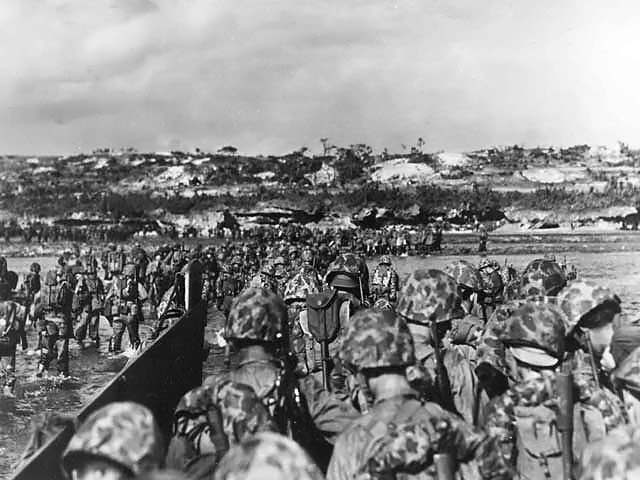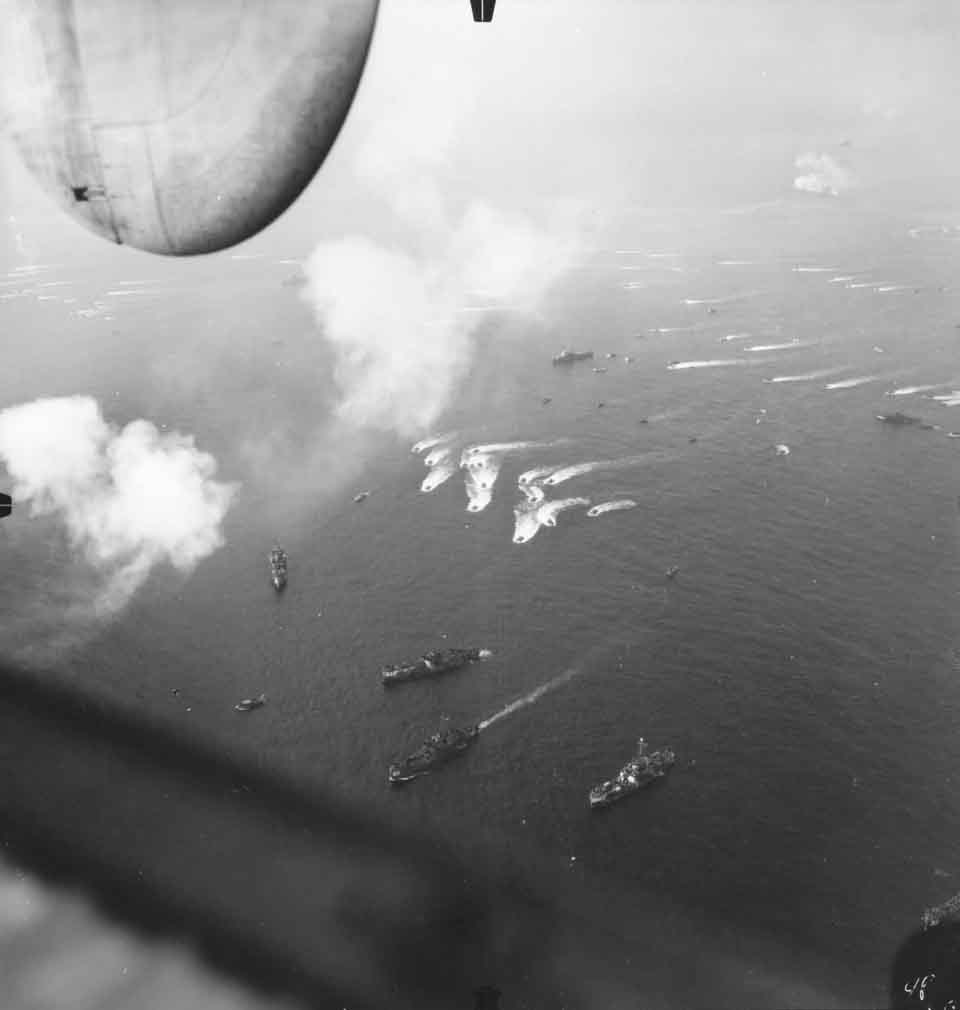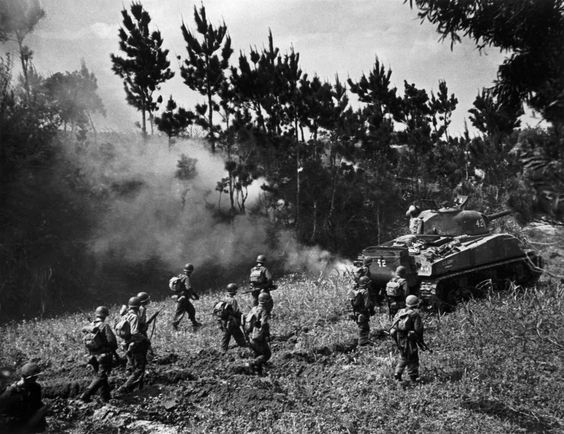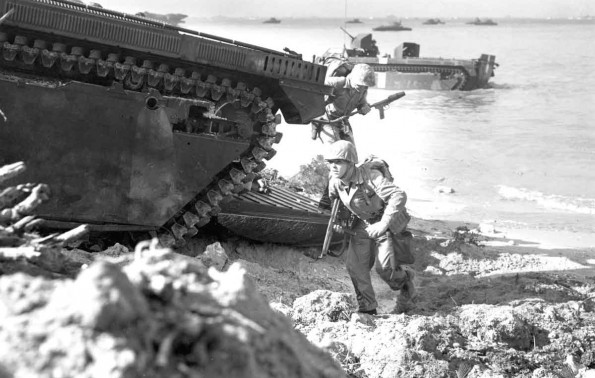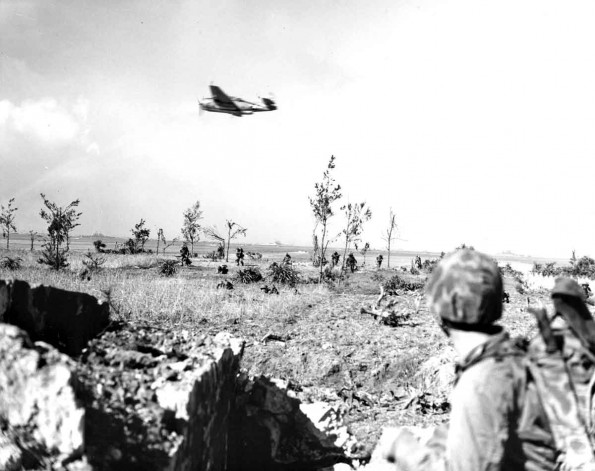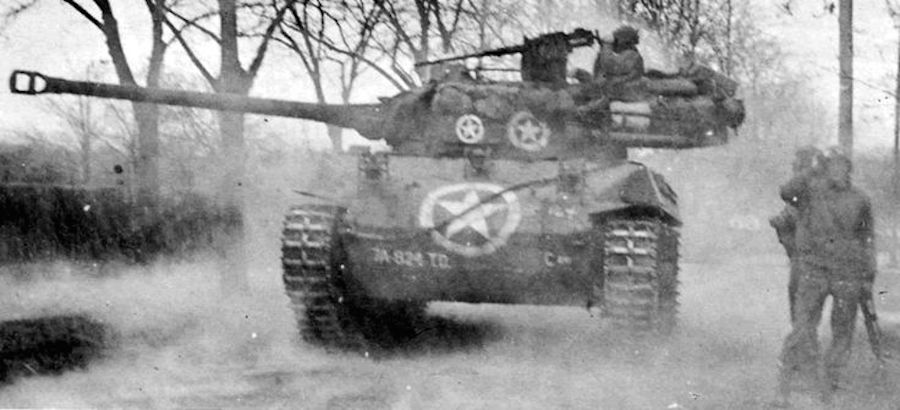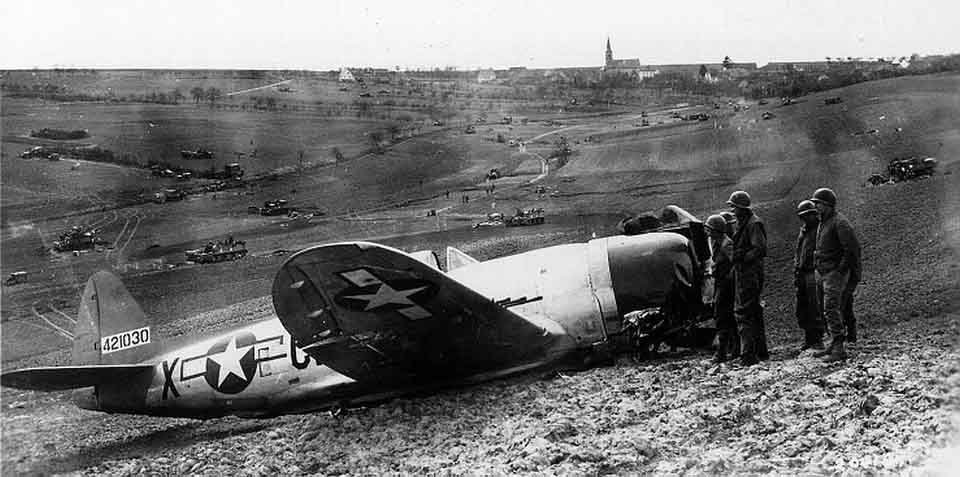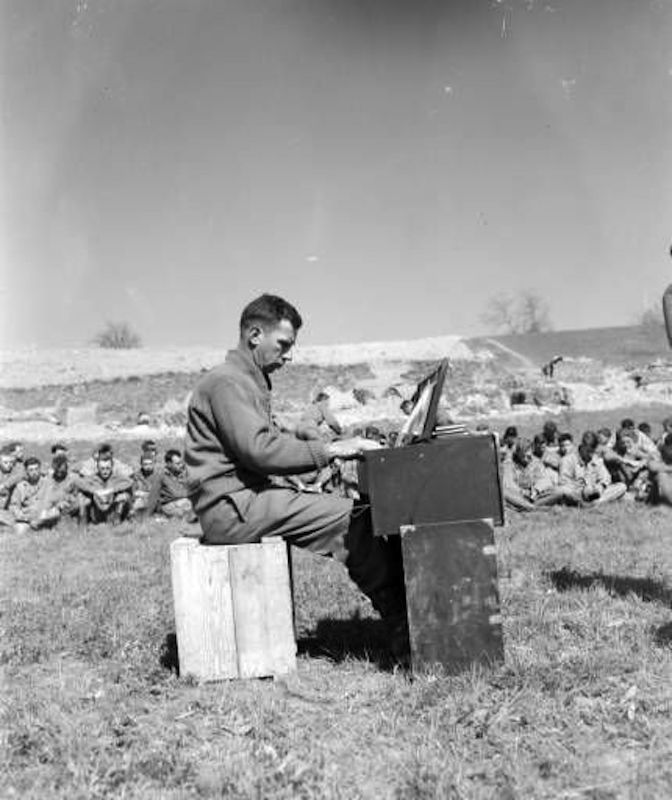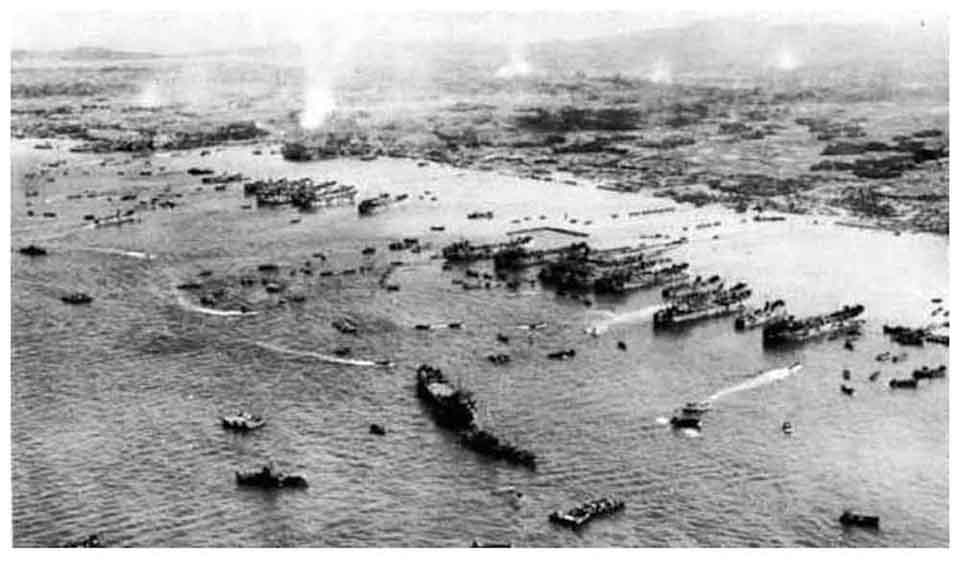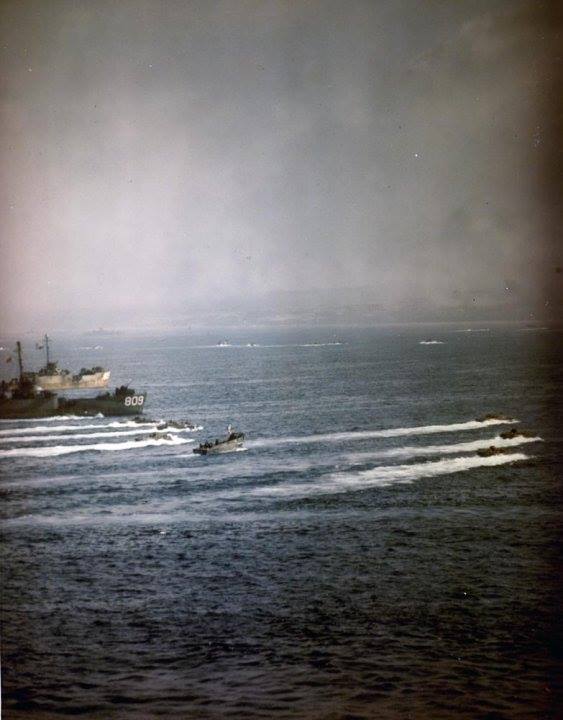Air Operations, CBI
BURMA- 10 10th Air Force B-25s attack roads and bridges in central Burma.
- 7 308th Heavy Bomb Group B-24s attack stores at Fort Bayard.
- 6 341st Medium Bomb Group B-25s and 6 14th Air Force P-51s attack warehouses and river traffic near Puchi and Sienning.
- 5 B-25s attack warehouses at Hsuchang.
- 3 B-25s attack a bridge at Changtuikuan.
- B-25s mount single-plane attacks against targets of opportunity at 4 locations.
- More than 70 fighter-bombers attack troops, transportation targets and targets of opportunity across southern and eastern China.
- 23 P-51 attack airfields in the Shanghai area.
- 3rd CACW Fighter Group P-51s down 5 twin-engined aircraft over Shanghai's Tachang airfield between 1215 and 1230 hours.
- 4 341st Medium Bomb Group B-25s attack rail targets.
Air Operations, East Indies
XIII Bomber Command B-24s attack the Oelin airfield on Borneo.
[Air Operations, Europe
RAF BOMBER COMMANDEvening Ops:
- 4 Mosquitos of No. 100 Group, operating from a forward airfield in France, patrols airfields in Southern Germany.
- 1 Mosquito is lost, hit by flak and seen to crash at Leipheim, a small airfield near Ulm.
ITALY:
- 12th Air Force B-25s attack rail bridges at seven locations.
- XXII TAC P-47s attack road and rail targets, especially bridges spanning the Po River.
- During the night, XXII TAC A-20s and A-26s attack communications targets and crossing points in the Po River valley.
AUSTRIA:
- 15th Air Force heavy bombers attack marshalling yards at five locations and one rail bridge.
- 82 15th Air Force P-38s attack a rail bridge.
- While escorting a 15th Air Force bombing mission, P-51 pilots of the 332nd Fighter Group's 301st Fighter Squadron down 12 Luftwaffe fighters over Wels about 1400 hours.
- 15th Air Force heavy bombers attack coastal batteries near Venice.
- 15th Air Force heavy bombers attack a rail bridge at Maribor.
Air Operations, Formosa
- 30 22nd and 43rd Heavy Bomb Group attack the Giran airfield.
- 18 38th Medium Bomb Group attack the airfield at Karenko.
- V Fighter Command sweep the island.
Air Operations, Japan
- During the night 115 of 121 73rd Very Heavy Bomb Wing B-29s dispatched attack an aircraft plant in Tokyo.
- 6 B-29s are lost.
- 6 313th Very Heavy Bomb Wing B-29s sow mines in the harbor at Kure.
Air Operations, Philippines
- Following an intense naval and air bombardment US 6th Army troops make an unopposed landing on Luzon's Legaspi Peninsula and quickly secure the town and airfield there. FEAF B-25s and A-20s support US 8th Army ground forces on Negros and near Cebu City.
- In anticipation of an amphibious landing by US 8th Army ground forces F4Us from Marine Air Group 12's VMF-115 and VMF-313 bombard Sanga Sanga and Bongao islands in the Sulu Archipelago's Tawi Tawi group, only 30 miles from Borneo.
Air Operations, Ryukyus
- US 10th Army invades Okinawa. More than 500 US Navy and Marine Corps carrier aircraft cover and support the invasion forces. Task Force 57 Royal Navy carrier aircraft attack targets in the Sakishima Islands.
- A VF-6 F6F downs and A6M Zero over Okinawa at 0013 hours and another over Okinawa at 0115 hours.
- A VF-10 F6F downs a G4M 'Betty' bomber at sea at 0145 hours.
- A VF-84 F4U downs 2 Ki-57 'Topsy' transport aircraft at sea at 0445 hours.
- 2 VC-85 FMs down a Ki-61 'Tony' fighter near Kerama Retto at 0600 hours.
- A VF-84 F4U downs a Ki-61 'Tony' fighter at sea at 0620 hours.
- VF-83 F6Fs down a Ki-43 'Oscar' fighter and a Ki-84 'Frank' fighter off Okinawa at 0750 hours.
- A VF-82 F6F downs a B6N 'Jill' torpedo bomber over Okinawa at 1830 hours.
- During the evening 2 US Navy transports are damaged by kamikazes.
Battle of the Atlantic
U-747 is sunk at Hamburg during a bombing raid by the US 8th Air Force.
| Class | Type VIIC |
| CO | Oberleutnant zur See Günther Zahnow |
| Location | North Sea, Hamburg |
| Cause | Air attack |
| Casualties | Unknown |
| Survivors | Unknown |
Burma
British Command Headquarters revises its plans and reorganizes its forces. The IV Corps, 15th and 17th Indian Divs and 255th Tank Bde, is to move toward Mandalay and Rangoon; the XXXIII Corps, British 2nd Div, 7th and 20th Indian Divs and the 268th Indian Bde of Infantry, will advance southwest along the Irrawaddy valley toward Prome. The 19th Indian Div will carry out mopping-up operations in the rear of the IV Corps.
[Eastern Front
The 3rd Ukraine Front captures Sopron, a major road junction between Budapest and Vienna, near the Austrian frontier southwest of Lake Neusiedler. The Soviet High Command orders the 2nd Ukraine Front to take Bratislava by April 5 or 6 and go on to the Morava, while the 3rd Ukraine Front marches on Vienna.
There is fierce fighting in the sector defended by the German Army Group Center, where the Germans claim to have destroyed 1,002 Soviet tanks in the last 10 days of March. Savage fighting continues at Breslau. The German garrison at Glogau is ordered to fight its way out to the west.
In East Prussia, the German 2nd Army contains the massive pressure of the 2nd and 3rd Belorussian Fronts. The last remaining ships of the German navy take part in the operation, namely the cruisers Prinz Eugen, Emden, Lützow, Scheer and Hipper. Naval and merchant ships have transported 85,000 men, including 70,000 wounded to Pomerania in the last 14 days.
GERMANYGlogan falls to the 1st Ukrainian Front's 13th Army.
HUNGARYThe Soviet 6th Guards Tank Army captures Sopron after a short engagement.[MORE]
[East China Sea
The British carrier HMS Indefatigable is hit by a kamikaze attack, suffering damage and 14 fatalities.
[Germany, Home Front
Radio Werwolf begins broadcasting. The radio station was created by Goebbels to rally Germans to suicidal resistance. Its repeated theme is besser tot als rot ('better dead than red').
[Italy
During the night, in the V Corps, British 8th Army, sector, the 2nd Commando Bde launches Operation ROAST to liberate the area of Comacchio.
[Japan, Home Front
All education for Japanese schoolchildren above the age of 6 is cancelled, and the young are redirected into war industries to provide a boost to the Japanese labor force.
[Japan, Planning
The Japanese Imperial General Headquarters adopts Ketsu, a plan for the defense of the home islands and China. Most Japanese forces in China will be withdrawn to the home islands, while the remainder of Japanese forces in China will consolidate along the southern coast of China, primarily to preclude any Allied invasions.
[Pacific
- The Japanese merchant cargo ship Karikawa Maru (6963t) sinks on a mine off Tsushima.
- The US submarine Queenfish (SS-393) inadvertantly sinks the Japanee relief ship Awa Maru (11,600t) in Formosa Straits. Although the ship was guaranteed safe passage, the submarine's commander did not see the markings in foggy weather.
Philippines
On Luzon in the south of the island, the 158th Regimental Combat Group of the US 6th Army lands, after air and naval bombardment, in the Bicol peninsula. The Japanese do not oppose the landing and the assault forces capture the town, the harbor and the airfield of Legaspi, and Libog. In the US I Corps sector, on the Villa Verde track, the Americans regain some of the ground recaptured by the Japanese the day before. The XI Corps outflanks the Shimbu line to the south.
[Western Front
While the Canadian II Corps, British 2nd Army, extends and reinforces the Emmerich bridgehead, the VIII Corps widens its bridgehead over the Dortmund-Ems Canal in the direction of Osnabrück. The US 9th and 1st Armies join up at Lippstadt, closing the circle around the rich industrial region of the Ruhr and cutting off the whole of Field Marshal Walther Model's Army Group B, 5th and 15th Armies, and 2 corps of the 1st Parachute Army, Army Group H, about 325,000 men. The pocket is about 70 miles long between the Rhine and the source of the Ruhr, and about 50 miles wide between the Sieg River in the south and the Lippe River in the north. While units of the XIX Corps, US 9th Army, reach the Cologne-Berlin autobahn, the XVI Corps pushes on in the sector south of Haltern. The 3rd Div, VII Corps, US 1st Army, seizes Paderborn.
In the US 7th Army sector the XV Corps is in difficulties around Aschaffenburg, while the XXI Corps pushes on northeast toward Würzburg and Königshofen and the VI advances along the Neckar River and makes contact with the French II Corps.
[Okinawa
Task Force 51, commanded by Vice-Adm Richmond K. Turner, begins the landing of the US 10th Army, Gen Simon B. Buckner, on the southwest coast of Okinawa, near Hagushi. The landing takes place at 8:30a.m. The 10th Army is made up of the XXIV Corps of the US Army under Gen John R. Hodge, with the 7th, 27th, 77th and 96th Divs of infantry and the III Amphibious Corps of Marines under Gen Roy S. Geiger, with the 1st, 2nd, 5th and 6th Marine Divs. The 7th and 96th Divs and the 1st and 6th Marine Divs take part in the first phase. The operation is code-name ICEBERG.
The operation is carried out by 180,000 combatant troops, 1,320 ships of all types, the 20th Air Force and the Marines tactical air force. These supporting services add another 368,000 men to the 180,000 on the ground, bringing the total to 548,000; it is the biggest amphibious operation so far carried out in the Pacific.
On the Japanese side, under Gen Mitsuru Ushijima, who has been in command of the Japanese 32nd Army since August 1944, the Ryukyu Islands are garrisoned by a total of 130,000 men. Of these 85,000 are stationed in Okinawa, made up as follows: the 24th Div of infantry, recently formed and not fully trained, the 62nd Div of infantry, brought over from China, experienced and aggressive, the 44th Independent Mixed Bde, half-destroyed during its transportation from Japan, and 1 tank regiment whose tanks have been dug in to act as so many block-houses. In the Motobu and Oroku peninsulas there are 3,500 seamen and 7,000 militarized citizens under command of Adm Minoru Ota, and another 20,000 men form the territorial militia. The Japanese are relying heavily on the navy's explosive boats and kamikaze pilots, organized by Vice-Adm Matome Ugachi, once Yamamoto's chief of staff. But while in the past there have been good pilots available, now Ugachi has to be content with cadets with few hours of active service flying. In the south of the island, the part assigned to Gen Hodge's XXIV Corps, a formidable defensive line has been prepared, the Shuri line.
In accordance with their accustomed tactics, never abandoned although demonstrated to be wrong, the first stage of the landings are unopposed. The landings are in the Hagashi area in the southwest of the island. Geiger's III Corps lands on the left with 6th and 1st Marine Divs providing the assault units. Hodge's forces on the right are 7th and 96th Inf Divs. Hodges is to deal with the south end of the island and Geiger to advance to the north. By the evening a solid beachhead 3 miles deep and 9 miles wide is established. Okinawa is 66 miles long and between 3 and 10 miles across, so that the penetration if very substantial.
The explanation for the lack of resistance is that the Japanese forces, 130,000 men of Gen Ushijima's 32nd Army, are entrenched in concealed positions and caves mostly to the south of the US landings on the Shuri Line. There are also 450,000 civilians on the island.
Throughout the battle at least two of the carrier groups of TF 58 will normally be available to give air support. The British TF 57 and the escort carrier groups will also be heavily involved. There will be almost daily bombardments by the heavy ships of TF 54. Japanese air operations, both conventional and kamikaze attacks, will be equally plentiful. On the first day the US battleship West Virginia (BB-48) and the British carrier Indomitable are hit along with 8 other ships including the attack cargo ships Achernar (AKA-53) and Tyrrell (AKA-80) and the attack transport Alpine (APA-92). Other ships damaged in the day's action include the destroyer Prichett (DD-561) by a dive bomber, the destroyer escort Vammen (DE-644) by a mine, the minesweeper Skirmish (AM-303) by a dive bomber and the attack transport Elmore (APA-42) by a high-level bomber.
[Images from April 1, 1945
|
|
|
|
|
|
|
|
|
|
|
|
